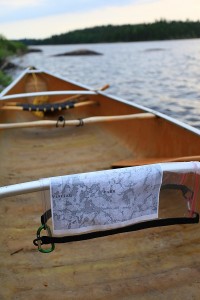 The Park is situated on a relatively flat plateau of granite rock about 2.5 to 3 billion years old. The tableland slopes from the east to west and slightly from south to north. The park’s most interesting and notable geological feature is a fault line that crosses the plateau from Wanipigow creek in the west, to Indian House lake in the east. The fault, called the Wanipigow-Wallace Lakes fault marks the contact and stress zones between two regions of sub-provinces of the large Superior province of the Canadian Shield. North of the line in the Berens river sub-province, the rocks are intrusive granite molded smooth in to “whale back” forms. South of the fault line, the Uchi sub-province , weathered granites again predominate; however the composition and texture of the rocks and the rough, broken topography reflect the influence of volcanic intrusions. The straight, deep shorelines of Donald and Royd lakes and adjacent long, linear creek systems trace the path of shearing and fracturing along the fault line.
The Park is situated on a relatively flat plateau of granite rock about 2.5 to 3 billion years old. The tableland slopes from the east to west and slightly from south to north. The park’s most interesting and notable geological feature is a fault line that crosses the plateau from Wanipigow creek in the west, to Indian House lake in the east. The fault, called the Wanipigow-Wallace Lakes fault marks the contact and stress zones between two regions of sub-provinces of the large Superior province of the Canadian Shield. North of the line in the Berens river sub-province, the rocks are intrusive granite molded smooth in to “whale back” forms. South of the fault line, the Uchi sub-province , weathered granites again predominate; however the composition and texture of the rocks and the rough, broken topography reflect the influence of volcanic intrusions. The straight, deep shorelines of Donald and Royd lakes and adjacent long, linear creek systems trace the path of shearing and fracturing along the fault line.
Glaciers scoured, scratched and molded the ancient bedrock. With glacial retreat about 12,000 years ago, the land was flooded by the waters of Lake Agassiz. Sands and gravel deposited throughout ages of varying water levels filled the lowlands and linear depressions. The course of the Bloodvein and the Gammon rivers follow deep water deposits of gigantic post glacial lakes. Woodland Caribou’s landscapes of elongated lakes, erratic drainage, abrupt changes in elevation, thin soils, bedrock outcrops and massive boulders bear testimony to the slow resurrection of this island plateau from a tomb of glacial ice and deep, cold freshwater seas.
An estimated 150 Woodland Caribou trek the lichen rich, granite hills of Woodland Caribou Provincial Park. Unlike their social northern cousins, the barren ground caribou, the secretive Woodland species seldom form large groups or herds. Their survival strategy seems to be based on a pattern of dispersion, with individuals living and traveling alone or in small groups. Scattered about the hinterlands may give each individual caribou a better chance of eluding predators, especially Timber Wolves or possibly Lynx or Black Bear – From the Official Park Map

